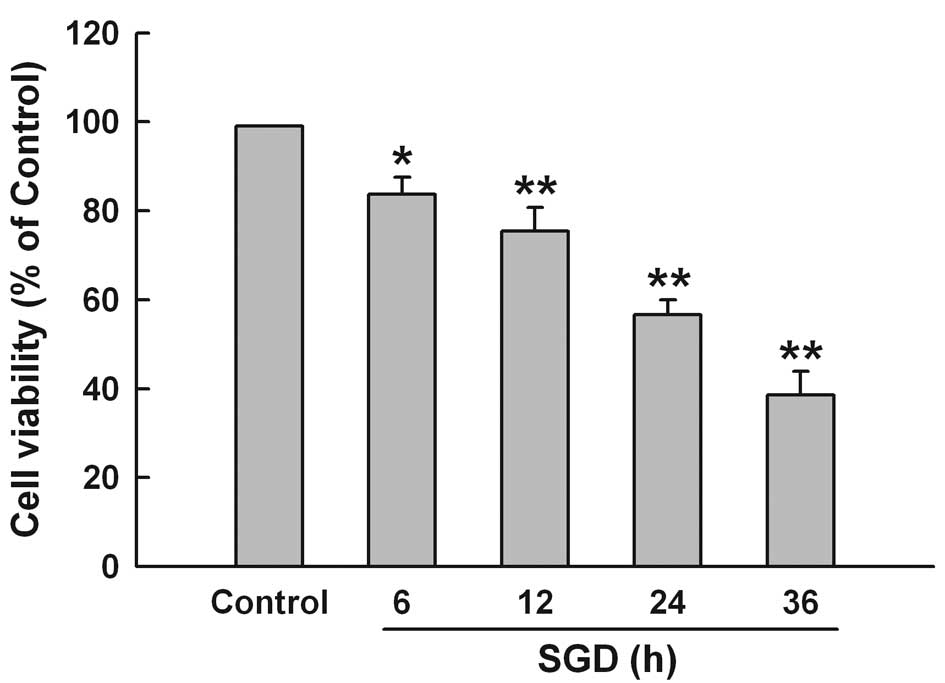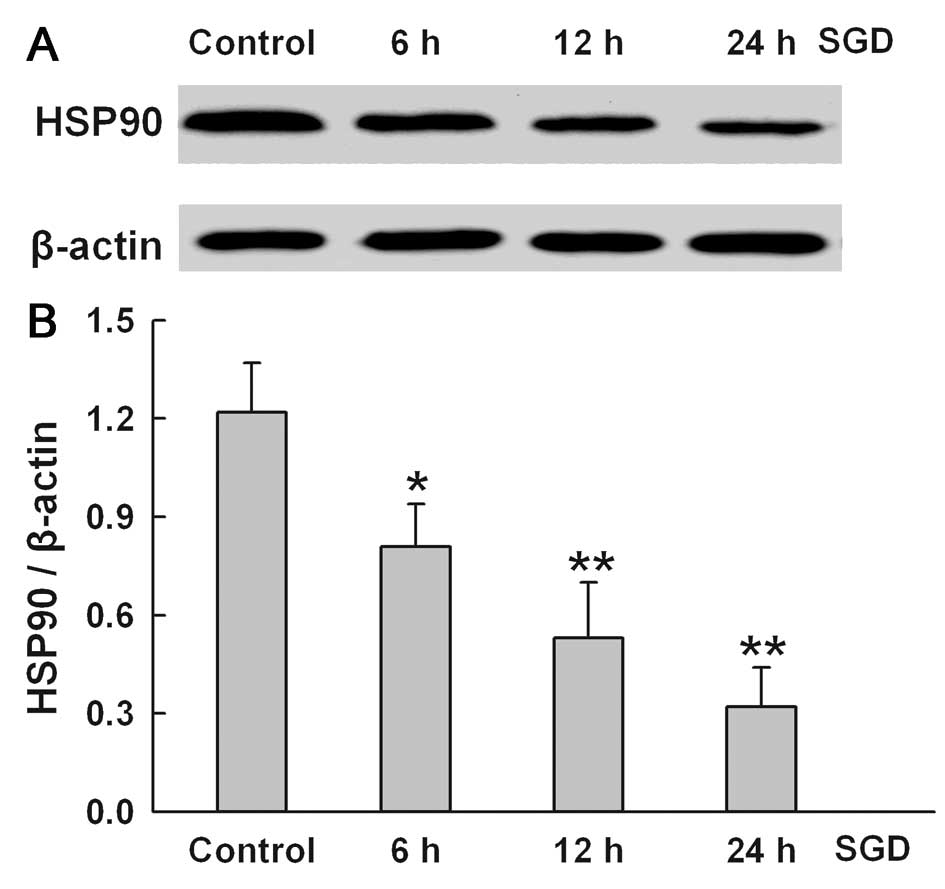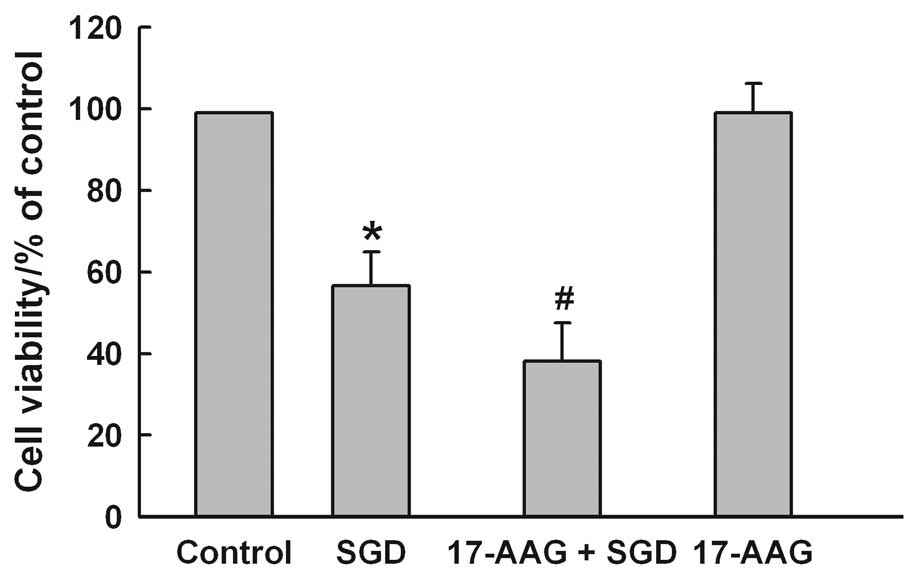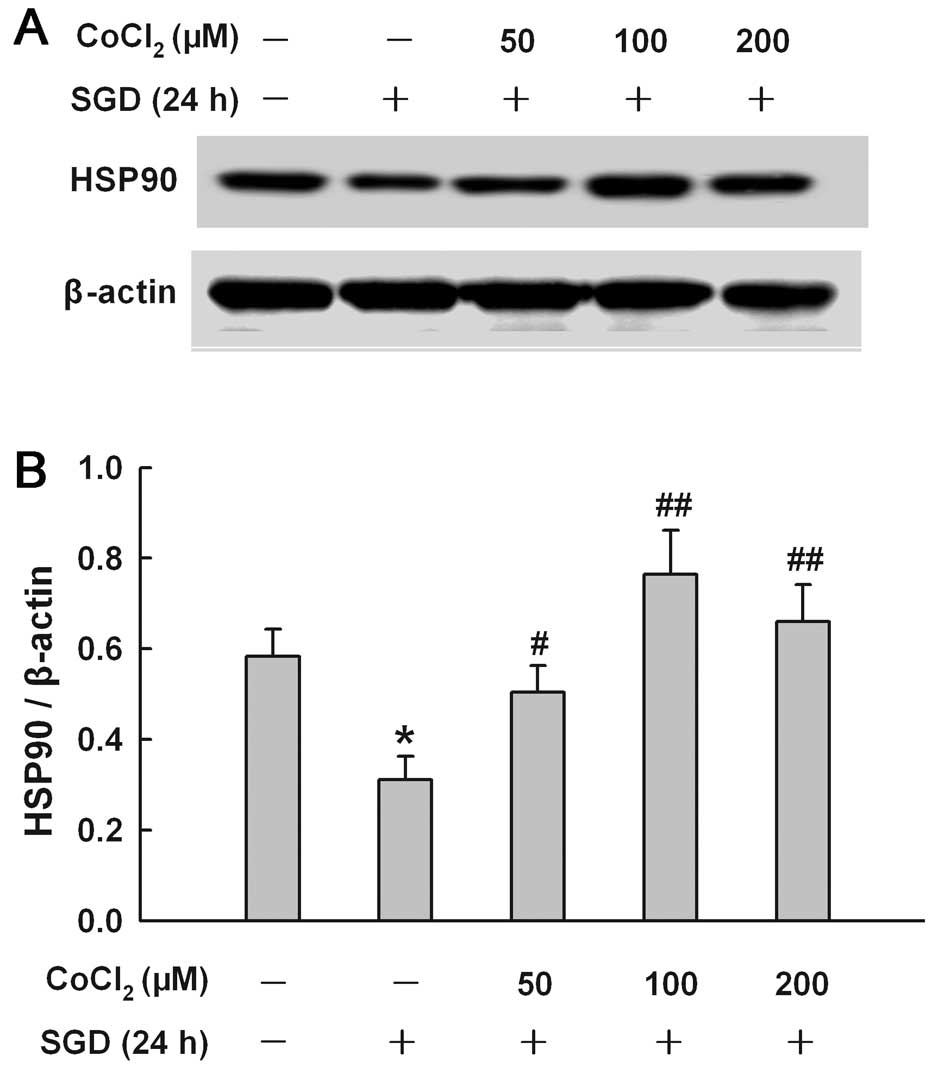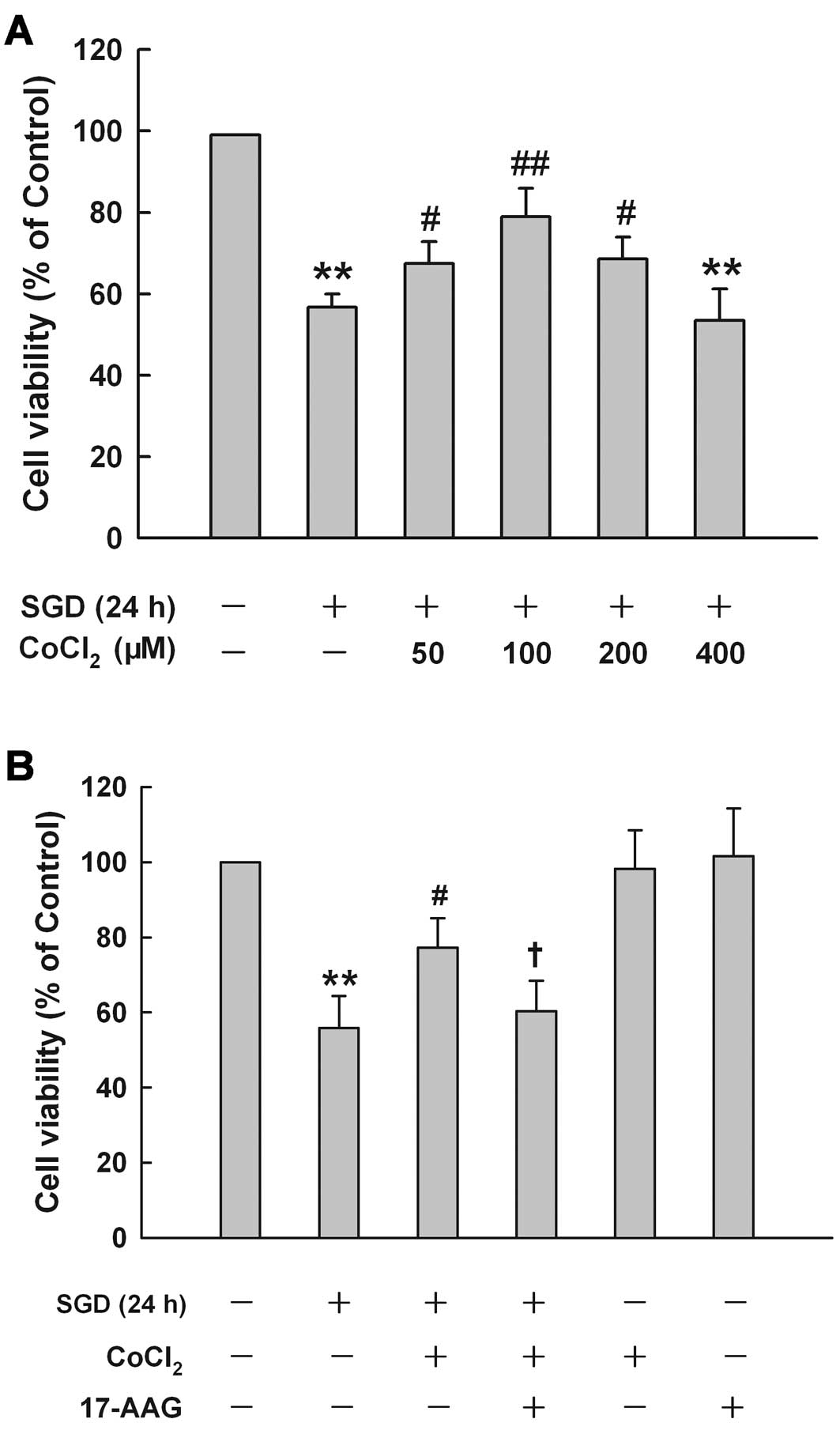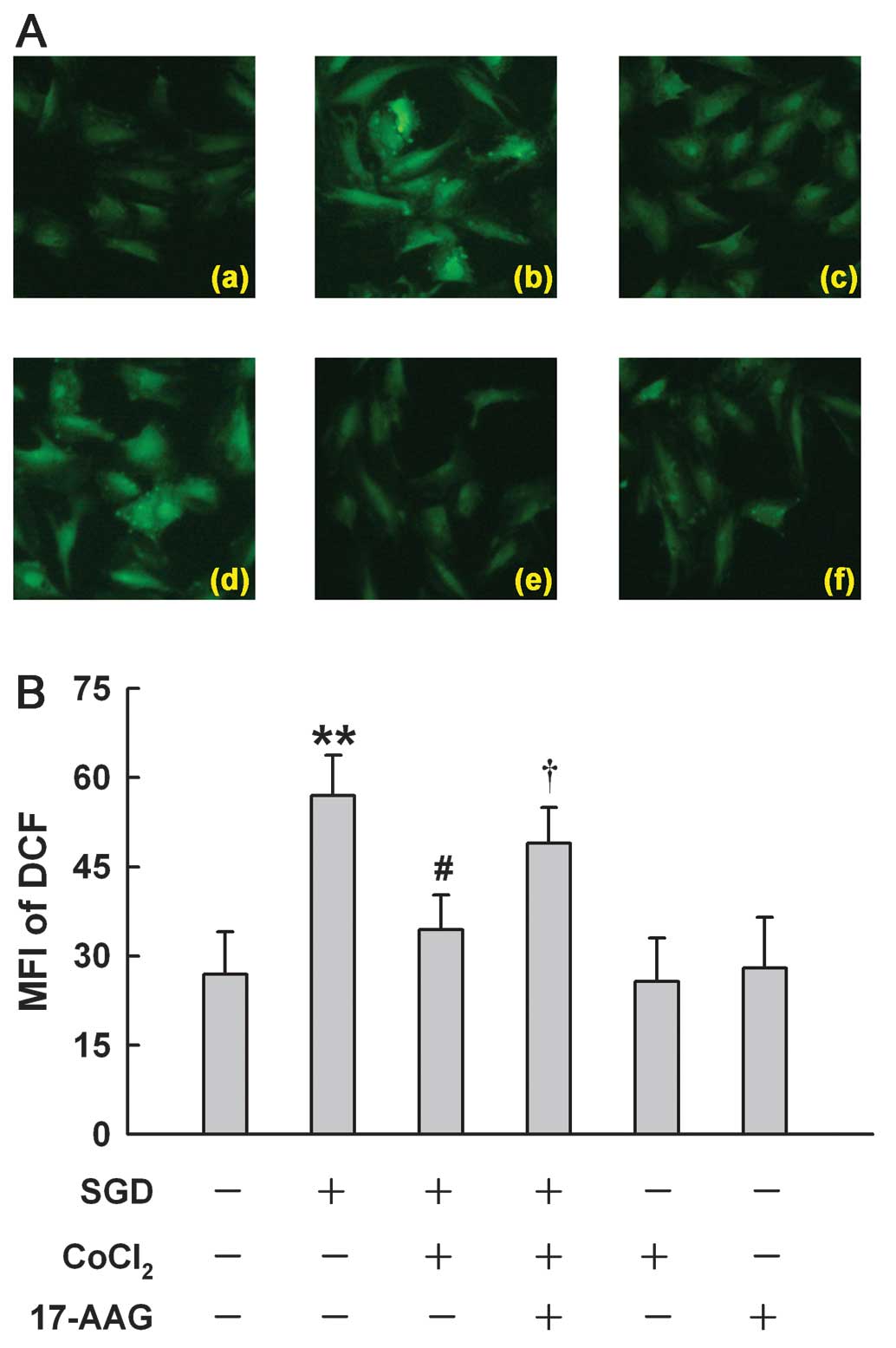Increased expression of heat shock protein 90 under chemical hypoxic conditions protects cardiomyocytes against injury induced by serum and glucose deprivation
- Authors:
- Published online on: August 20, 2012 https://doi.org/10.3892/ijmm.2012.1099
- Pages: 1138-1144
Abstract
Introduction
The cardiac oxygen-sensing mechanism has attracted extensive attention. A variety of genes relating to hypoxia adaptation are induced at low-oxygen tensions, including erythropoietin (EPO), vascular endothelial growth factor (VEGF), glycolytic enzymes, glucose transporters, heme proteins, and hypoxia inducible factor-1 (HIF-1) in various cell types (1–4). The HIF-1 is the first identified family of transcription factors that are rapidly elicited by hypoxia by inhibition of their ubiquitin-dependent degradation (5). Previously, the important role of HIF-1 in the cellular mechanism of oxygen-sensing was demonstrated by confirming that the upregulation of 89% of genes induced by hypoxia is HIF-1-dependent (6). In their study, Baird et al (7) reported that heat shock proteins (HSPs) are regulated by HIF-1 during hypoxia.
It has been well documented that cobalt chloride (CoCl2) is a well-known hypoxia mimetic agent that mimics the hypoxic response in various ways (3). CoCl2-mimicked hypoxia enhances the level of HIF-1α protein (8–10). Thus, CoCl2 has been used to explore the cardiac oxygen-sensing mechanism in various experiment models. In isolated, perfused rat hearts in hypoxia/reoxygenation, prior chronic oral CoCl2 improves cardiac functions by increasing the levels of VEGF, aldolase-A, and glucose transporter-1 (11). Furthermore, CoCl2 pretreatment before prolonged deep hypothermic circulatory arrest (DHCA) rescues myocardial apoptosis by mechanisms involving the phosphorylation of Akt, upregulation of the antiapoptotic protein Bcl-2 expression and a decreased expression of the proapoptotic protein Bax (12). These results showed that preconditioning with CoCl2 protects against cardiac injury induced by hypoxia or ischemia. The clinical significance of such a strategy, however, is limited by the unpredictability of hypoxia or ischemia time. The postconditioning has been developed and has a similar effect as preconditioning in a canine model of reversible coronary occlusion (13). Since the hypoxia and/or ischemia-related diseases or injuries are clinically common, developing a new therapeutic strategy for treatment of these diseases or injuries is essential. Since cobalt has been administered to human patients for the treatment of anemia (14), and induces several hypoxia-related protective factors, such as EPO (15,16), HSP90 (17) and heme oxgenase-1 (HO-1) (18,19), we speculates that the co-existence of low concentrations of CoCl2 with serum and glucose deprivation (SGD) is likely to attenuate ischemia-like injury in cardiomyocytes.
To test this hypothesis, we undertook to examine the protective effect of low concentrations of CoCl2 against SGD-induced injury of H9c2 cardiomyocytes (H9c2 cells), as well as the role of HSP90 in this cardioprotection and its mechanisms. The findings of the present study have demonstrated that the co-treatment of CoCl2 significantly protects H9c2 cells against SGD-induced injury. Activation of the oxygen-sensing mechanism by CoCl2 upregulates the expression of HSP90, which is an important CoCl2-induced adaptive response to the SGD condition. Such molecular adaptation to ischemia-like events may contribute to the functional improvement of cardiomyocytes, including antioxidation and the preservation of MMP.
Materials and methods
Materials
CoCl2, glucose, 17-allylamino-17-demethoxygelda-namycin (17-AAG), dichlorofluorescin diacetate (DCFH-DA) and Rhodamine 123 (Rh123) were purchased from Sigma-Aldrich Corporation (St. Louis, MO, USA). HSP90 antibody was purchased from Bioworld Technology (Minneapolis, MN, USA). The cell counter kit-8 (CCK-8) was purchased from Dojindo Laboratories (Kyushu, Japan). Glucose-free DMEM medium and fetal bovine serum (FBS) were supplied by Gibco-BRL (Calsbad, CA, USA).
Cell culture and treatments
H9c2 cells were obtained from Sun Yat-sen University Experimental Animal Centre (Guangzhou, China). The H9c2 cell line, a subclone of the original clonal cell line, was derived from embryonic rat heart tissue. The cells were cultured in DMEM medium supplemented with normal glucose (5.5 mM) and 15% FBS at 37°C under an atmosphere of 5% CO2 and 95% air.
H9c2 cells were incubated in glucose- and FBS-free DMEM medium to set up a model of SGD and mimic ischemia-induced cardiac injury. CoCl2 was added into the above DMEM medium to examine its cytoprotective effects. The selective HSP90 inhibitor, 17-AAG, was administered for 60 min prior to exposure of the H9c2 cells to CoCl2 and SGD.
Cell viability assay
Cell viability was detected by the CCK-8 kit. H9c2 cells were cultured in 96-well plates at a density of 5,000 cells/well. When the cells were ∼70% fused, the indicated treatments were performed. After the treatments, 10 μl CCK-8 solution was added into each well and the plates were incubated for 3 h. The absorbance at 450 nm was measured with a microplate reader (Molecular Devices, Sunnyvale, CA, USA). A mean optical density (OD) of 4 wells in each group was used to calculate percentage of cell viability using the formula: percentage of cell viability = OD treatment group/OD control group x100%. Experiments were performed in triplicate.
Western blotting
At the end of the treatments, the H9c2 cells were harvested and lysed with ice-cold cell lysis solution and the homogenate was centrifuged at 10,000 x g for 12 min at 4°C. Total protein in the supernatant was quantified using a BCA protein assay kit. Total protein (20 μg) from each sample was separated by 12% SDS-PAGE. The protein in the gel was transferred into polyvinylidene difluoride (PVDF) membrane. The membrane was blocked with 5% fat-free milk in TBS-T for 2 h at room temperature, and then incubated with the primary antibodies specific to HSP90 (1:2,000), or β-actin (1:8,000) with gentle agitation at 4°C overnight, followed by horseradish peroxidase-conjugated secondary antibodies for 60 min at room temperature. After three washes with TBS-T, the membranes were developed using an enhanced chemi luminescence and exposed to X-ray film. To quantify the protein expression, the X-ray film was scanned and analyzed using ImageJ 1.46i software (National Institutes of Health, USA).
Measurement of intracellular reactive oxygen species (ROS) level
Intracellular ROS was determined by the oxidative conversion of cell-permeable DCFH-DA to fluorescent DCF. H9c2 cells were cultured on a slide in DMEM-F12 medium. After the indicated treatments, the slides were washed twice with phosphate-buffered saline (PBS). DCFH-DA solution in serum-free medium was added at a concentration of 10 μM and co-incubated with H9c2 cells at 37°C for 60 min. The slides were washed three times, and DCF fluorescence was measured over the entire field of vision using a fluorescent microscope connected to an imaging system (BX50-FLA; Olympus). Mean fluorescence intensity (MFI) from three random fields was analyzed using ImageJ 1.46i software and the MFI of DCF represented the amount of ROS.
Measurement of mitochondrial membrane potential (MMP)
MMP was monitored with a fluorescent dye Rh123, a cell-permeable cationic dye that preferentially enters into mitochondria based on the highly negative MMP. Depolarization of MMP results in the loss of Rh123 from mitochondria and a decrease in intracellular green fluorescence. Rh123 (100 mg/l) was added into cell cultures for 30 min at 37°C and fluorescence was measured over the entire field of vision with a fluorescent microscope connected to an imaging system (BX50-FLA; Olympus). MFI of Rh123 from three random fields was analyzed using ImageJ 1.46i software and MFI was regarded as an index of the level of MMP.
Statistical analysis
Data were shown as the mean ± SE. The assessment of differences between groups was analyzed by Tukey’s test of one-way ANOVA with OriginPro 8.0 (OriginLab Corporation, Northampton, MA, USA). P<0.05 was considered to indicate statistical significance.
Results
SGD time-dependently enhances cytotoxicity in H9c2 cells
To test the effect of SGD on cytotoxicity in H9c2 cells, the CCK-8 assay was performed. Fig. 1 shows that SGD obviously induced cytotoxicity, leading to a time-dependent decrease in cell viability. Cell survival was decreased to 56.7±3.3% by 24 h of incubation in serum- and glucose-free medium. Therefore, 24 h of SGD was used as an effective injury time in the subsequent experiments.
SGD downregulates the expression of HSP90 in H9c2 cells
To determine the effect of SGD on HSP90 expression, the changes in HSP90 expression were tested in serum- and glucose-deprived H9c2 cells for the indicated times (6, 12 and 24 h), respectively. SGD attenuated HSP90 expression in a time-dependent manner, suggesting that the downregulation of HSP90 expression may be one of the mechanisms involved in SGD-induced injury in the H9c2 cells (Fig. 2). The results of subsequent experiments showed that pretreatment of the cells with 2 μM 17-AAG, a selective inhibitor of HSP90, for 60 min before SGD for 24 h markedly aggravated SGD-induced cytotoxicity, evidenced by a further decrease in cell viability (Fig. 3). However, 17-AAG alone did not alter cell viability in H9c2 cells. These results showed that HSP90 may be one of the molecular defensive mechanisms against SGD-induced injury in H9c2 cells.
CoCl2 time-dependently upregulates the expression of HSP90 in H9c2 cells
As shown in Fig. 4, when H9c2 cells were treated with 100 μM CoCl2 for 6–24 h, a time-dependent increase in HSP90 expression was found.
CoCl2 reduces the inhibitory effect of SGD on the expression of HSP90 in H9c2 cells
To explore the effect of chemical hypoxia on the SGD-induced inhibition of HSP90 expression, H9c2 cells were treated with CoCl2 at concentrations ranging from 50 to 200 μM for 24 h in the presence of SGD, respectively. Fig. 5 shows that co-treatment with CoCl2 at 50, 100 and 200 μM inhibited the downregulation of the SGD-induced HSP90 expression. A maximal inhibitory effect of CoCl2 was observed at 100 μM.
HSP90 contributes to the cytoprotection at low concentrations of CoCl2 against SGD-induced cytotoxicity in H9c2 cells
CoCl2 at different concentrations had different effects on SGD-induced cytotoxicity in H9c2 cells (Fig. 6A). Treatment of cells with low concentrations (50, 100 and 200 μM) obviously protected against SGD-induced cytotoxicity, leading to an increase in cell viability. These concentrations demonsrated a maximum cytoprotective effect of CoCl2 at 100 μM, which alone did not affect cell viability (data not shown). Therefore, 100 μM of CoCl2 was used as an effective protection concentration in the subsequent experiments. These results suggest that sublethal chemical hypoxia treatment is protective against ischemia-like injury.
To investigate the role of HSP90 in the cytoprotective effect of CoCl2 at low concentrations against SGD-induced injury, H9c2 cells were pretreated with 2 μM 17-AAG, a selective inhibitor of HSP90, for 60 min prior to the co-treatment of 100 μM CoCl2 with SGD for 24 h. Fig. 6B shows that cell treatment with 100 μM CoCl2 considerably reduced SGD-induced cytotoxicity, evidenced by an increase in cell viability. However, this cytoprotection of CoCl2 treatment was reduced by 17-AAG pretreatment, suggesting that HSP90 is involved in the protective effect of sublethal chemical hypoxia against cardiac toxicity induced by SGD in H9c2 cells. However, 2 μM 17-AAG alone did not alter cell viability.
HSP90 participates in the antioxidant effect induced by a low concentration of CoCl2 in H9c2 cells
A more recent study showed that a high concentration (600 μM) of CoCl2 induces ROS generation in H9c2 cells (17). Of note, we found that CoCl2 at 100 μM reduced SGD-induced ROS generation, manifesting a decrease in DCF-derive fluorescence (an index of ROS level) (Fig. 7Ac). However, the antioxidant effect of 100 M CoCl2 was markedly suppressed by the inhibition of HSP90 with 17-AAG at 2 μM (Fig. 7Ad). Alone, 100 μM CoCl2 or 2 μM 17-AAG did not alter the basal level of ROS. These results indicated that the antioxidant effect of low concentrations of CoCl2 may be associated with an upregulated HSP90 expression.
HSP90 is associated with the mitochondrial protection induced by low concentrations of CoCl2 in H9c2 cells
Fig. 8 shows that after H9c2 cells were subjected to SGD for 24 h, mitochondria were markedly damaged, leading to a decrease in the uptake of Rh123, demonstrating dissipation of MMP (Fig. 8Ab). The loss of MMP was reduced by treatment with 100 μM CoCl2 for 24 h (Fig. 8Ac). The inhibition of HSP90 by 17-AAG (2 μM) pretreatment significantly depressed the mitochondrial protection induced by CoCl2, resulting in the severe loss of MMP, suggesting that low concentrations of CoCl2 provide mitochondrial protection by enhancing HSP90 expression.
Discussion
The important findings of this study are that co-treatment of low concentrations of CoCl2 with SGD provides cardioprotection against ischemia-like injury in H9c2 cells and that HSP90 contributes to the cardioprotective effect of sublethal chemical hypoxia from SGD-induced injury through its antioxidation and mitochondrial protection. The present study provides novel evidence to support the hypothesis that sublethal endogenous hypoxia may be one of the defensive mechanisms by which cardiomyocytes become more resistant to ischemia-induced injury and that cobalt, a traditional medicine, may have therapeutic efficacy for the treatment of ischemia-related cardiac diseases.
Previous studies have shown that pretreatment with CoCl2, a well-known hypoxia mimetic agent, offers cardioprotective effects, including attenuation of myocardial apoptosis (12) and improvement of cardiac contractile functions (11). Consistent with these studies (11,12), in the present study, we found that co-treatment of 100 μM CoCl2, which does not damage H9c2 cells, is able to protect against SGD-induced injury, leading to an increase in cell viability, a decrease in ROS generation and a preservation of MMP. Due to the unpredictability of hypoxia or ischemia timing, the clinical significance of hypoxia preconditioning is limited. Since co-treatment with CoCl2 has a similar cardioprotection as CoCl2 preconditioning, the administration of cobalt used in this study has potential clinical significance for the treatment of ischemia-related heart diseases. Furthermore, our results provide new data to demonstrate the inhibitory effect of cobalt on ischemia-like cardiac injury.
Based on our findings and those of previous studies (11,12,15–19), several possible mechanisms are responsible for the cardioprotective effect of low concentrations of CoCl2: i) its antioxidant effect, by which CoCl2 is able to reduce SGD-induced ROS generation in H9c2 cells. Consistent with our findings, a previous study has shown that manganese-containing superoxide dismutase (SOD) and mitochondrial-targeted catalase significantly protects against cytotoxicity and the glucose deprivation-induced oxidative stress (20); ii) its mitochondrial protective effect, by which CoCl2 inhibits the SGD-induced dissipation of MMP. Similarly, cobalt has been shown to have direct action in preserving ATP in adult rat myocardium (21); iii) its enhancement effect on HIF-1 expression, by which CoCl2 is capable of protecting isolated mouse hearts against ischemia/reperfusion (I/R)-induced injury (22); iv) its upregulation effect on EPO, which is one of the target products of HIF-1. Cai et al (23) reported that hearts exposed to intermittent hypoxia or EPO are protected from I/R-induced injury. Previous studies have demonstrated the effectiveness of EPO in limiting apoptosis in rat cardiac myocytes (24,25); v) its enhancing the levels of VEGF, by which low concentrations of CoCl2 improves cardiac contractile functions (11). VEGF is a potent angiogenic factor and its upregulation may facilitate tissue perfusion and oxygenation in hypoxia, an important adaptation to hypoxia; vi) its inductive effect of glucose transporters (GLUT). In the in vivo heart and cultured cardiac cells, both hypoxia and Co2+ rapidly induce GLUT-1 expression in the mRNA level (26,27). The increased GLUT-1 is involved in improved cardiac contractile function in hypoxia-reoxygenation in rats treated with low concentrations of CoCl2 (11).
Besides the above six possible mechanisms underlying the cardioprotection of low concentrations of CoCl2, another important mechanism involves the activation of the oxygen-sensing mechanism by CoCl2, which may upregulate the expression of HSPs. HSPs are a family of protective proteins, which provide an endogenous cell defense mechanism against hostile environmental stress, including hypoxia and ischemia. Accumulating evidence has shown that the upregulation of HSP expression is capable of protecting cardiomyocytes from I/R-induced damage (28) or chemical hypoxia-triggered injury (17). Notably, CoCl2 is also able to upregulate the expression of HSP90 in H9c2 cells (17). Based on these previous studies (17,29), we hypothesizes that HSP90 possibley contributes to the cardioprotective effect of co-treatment with low concentrations of CoCl2 from SGD-induced cardiomyocyte injury. In the present study, we initially observed that SGD downregulated the expression of HSP90 and that 17-AAG, a selective inhibitor of HSP90, significantly aggravated SGD-induced cytotoxicity in H9c2 cells, suggesting that HSP90 is an endogenous protective protein against SGD-induced injury. Secondly, we found that co-treatment with 100 μM CoCl2, not only enhanced the expression of HSP90, but also obviously blocked the inhibitory effect of SGD on HSP90 expression. Thirdly, examination into the roles of HSP90 in the cardioprotection of low concentrations of CoCl2 against SGD-induced injuries, including cytotoxicity, overproduction of ROS and dysfunction of mitochondria was conducted. The findings of the present study have shown that the inhibition of HSP90 by 17-AAG markedly blocked the reduction of cytotoxicity induced by CoCl2 at 100 μM, indicating the involvement of HSP90 in the cardioprotective effect of CoCl2 against SGD-triggered injury. Our results are comparable with those of a recent study whereby the inhibition of HSP90 by geldanamycin, an inhibitor of HSP90, or siRNA completely eliminates the protective effect of hypoxic pretreatment against prolonged hypoxia/reoxygenation-elicited damage in H9c2 cells (30). Yang et al (17) also reported that increased HSP90 expression participates in the cardioprotection induced by hydrogen sulfide (H2S).
ROS is regarded as a toxic byproduct of aerobic metabolism following reoxygenation after periods of ischemia or hypoxia (31). Ahmad et al (20) indicated that mitochondrial ROS mediate glucose deprivation-induced cytotoxicity. In this study, it was shown that co-treatment with low concentrations of CoCl2 attenuated cytotoxicity, along with a decrease in ROS production, suggesting that co-treatment with CoCl2 is likely to induce antioxidants to reduce ROS generation. Findings of a more recent study have demonstrated the involvement of HSP90 in the antioxidant effect of H2S (17). In agreement with this evidence, our data showed that 17-AAG significantly depressed CoCl2-induced inhibitory effect on the overproduction of ROS elicited by SGD in H9c2 cells, demonstrating that HSP90 is involved in the antioxidant effect of CoCl2.
Mitochondria play a critical role in determining the cell fate (32) by regulating the mitochondrial permeability transition pore (PTP) and the release of a number of apoptotic factors. Cell death inhibition is accompanied by MMP preservation (17,33–35). Since antioxidants are able to inhibit the loss of MMP, the role of HSP90 in the CoCl2-induced cardioprotective effect may be associated with the preservation of mitochondrial function. In this study, co-treatment with CoCl2 considerably inhibited SGD-induced loss of MMP, and this mitochondrial protective function was blocked by the inhibition of HSP90 by 17-AAG. Our findings are supported by those of Yang et al (17) and are consistent with a recent finding that HSP90 is required for mitochondrial protein import for hydrophobic membrane proteins, especially under stress conditions (36).
Taken together, in the present study, we have demonstrated that chemical hypoxia-upregulated HSP90 expression contributes to the CoCl2-induced cardioprotective effect from SGD-triggered injury by depressing cytotoxicity and oxidative stress as well as preserving MMP. However, more experiments are required to elucidate the activation of the cardiac oxygen-sensing mechanism by CoCl2, in particular, the interaction between HIF-1 and HSP90.
Acknowledgements
The present study was supported by the Science and Technology Planning Project of Guangdong in China (nos. 2011B031800002 and 2011B080701051) and the Guangdong Natural Science Foundation (no. S2011010002620).



